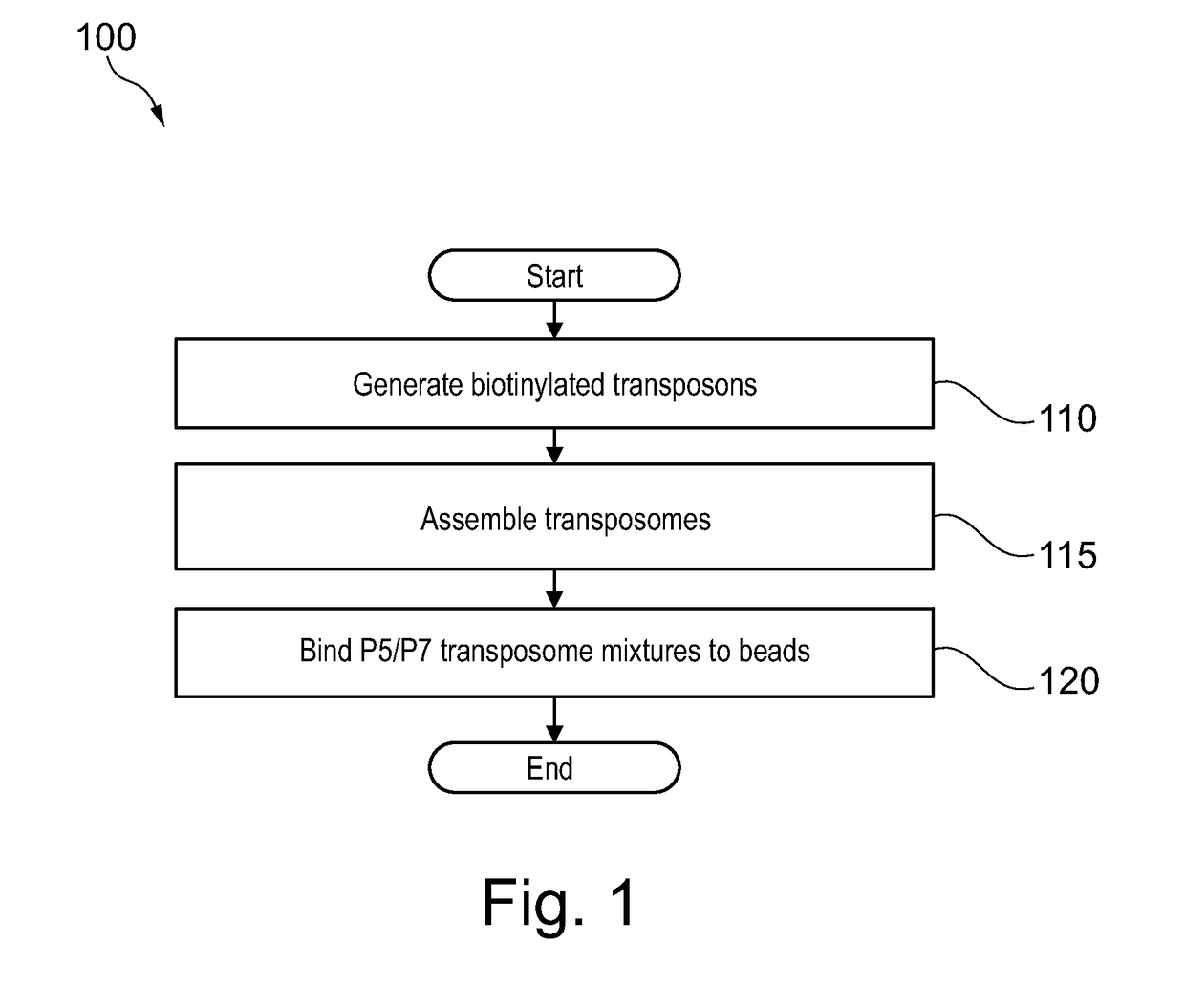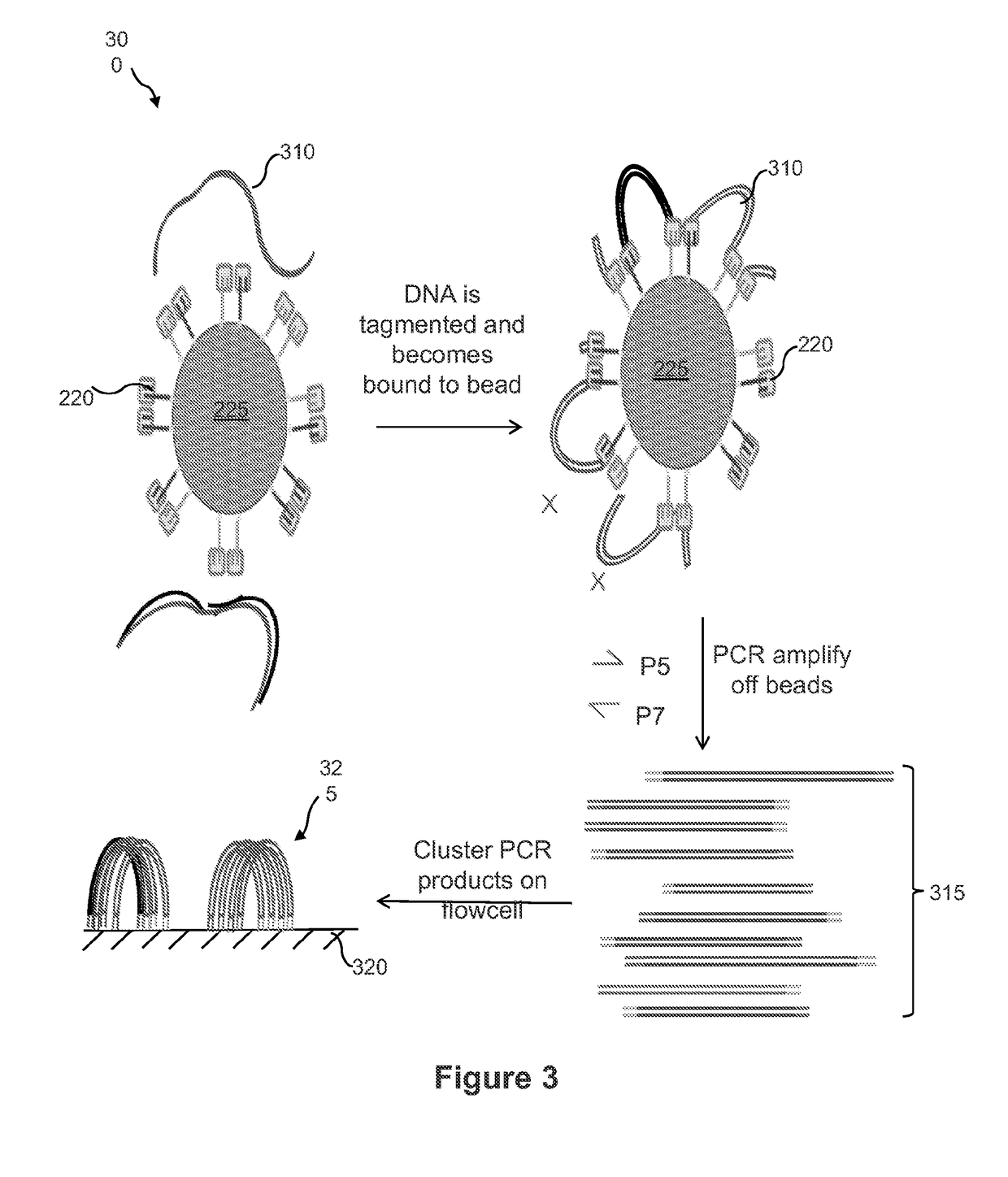Contiguity preserving transposition
a technology of contiguity and translocation, applied in the field of sequence nucleic acids, can solve the problem of enormous information generated from a single sequencing run
- Summary
- Abstract
- Description
- Claims
- Application Information
AI Technical Summary
Benefits of technology
Problems solved by technology
Method used
Image
Examples
example 1
DNA Cluster Yield from the Bead-Based Tagmentation Process
[0216]DNA cluster yield from the bead-based tagmentation process of FIG. 3 were evaluated and shown in the table of FIG. 4. In this example, 50, 250, and 1000 ng of human NA12878 DNA were tagmented using the same batch of tagmentation beads (2.8 μm beads). A second 50 ng aliquot of NA12878 DNA was tagmented using a second batch of tagmentation beads (full repeat; 2.8 μm beads). The bead-bound tagmented DNA samples were PCR amplified and purified. An aliquot (5.4 μL) of each purified PCR product (unquantified) was diluted 270 fold to make stock sample solutions of about 50 pM. For each sample, the 50 pM stock solution was diluted to 15, 19, 21, and 24 pM. The diluted samples were loaded onto a flow cell for cluster generation and sequencing. The data show that starting from the same dilution (˜50 pM), cluster numbers are between 100-114% for the three different input levels (i.e., 50, 250, and 1000 ng) using the same set of be...
example 2
Reproducibility of the Bead-Based Tagmentation Process
[0217]The reproducibility of the bead-based tagmentation process of FIG. 3 is shown in FIG. 5. In this example, six different preparations of indexed beads (indexes 1 through 6; 2.8 μm beads) made at the “same” transposome density were used to prepare tagmented DNA using 50 and 500 ng of input NA12878 DNA. The tagmented DNA was PCR amplified and purified. The 12 purified PCR products were pooled into two mixtures (pool 1 and pool 2) of six for two HiSeq lanes. Each pool includes 3-50 ng and 3-500 ng samples per lane. Data table 500 shows the median insert size and the mean insert size for each indexed sample.
example 3
Insert Size of Pool 1 and the Insert Size of Pool 2
[0218]The insert size of pool 1 and the insert size of pool 2 are shown in FIG. 6A (Plot 600) and FIG. 6B (Plot 650), respectively, of the indexed samples of FIG. 5. The data also shows that the insert size is uniform between the six different preparations of indexed beads. Bead-based tagmentation provides a mechanism to control the size of the inserts and DNA yield.
PUM
| Property | Measurement | Unit |
|---|---|---|
| surface area per volume | aaaaa | aaaaa |
| diameter | aaaaa | aaaaa |
| diameter | aaaaa | aaaaa |
Abstract
Description
Claims
Application Information
 Login to View More
Login to View More - R&D
- Intellectual Property
- Life Sciences
- Materials
- Tech Scout
- Unparalleled Data Quality
- Higher Quality Content
- 60% Fewer Hallucinations
Browse by: Latest US Patents, China's latest patents, Technical Efficacy Thesaurus, Application Domain, Technology Topic, Popular Technical Reports.
© 2025 PatSnap. All rights reserved.Legal|Privacy policy|Modern Slavery Act Transparency Statement|Sitemap|About US| Contact US: help@patsnap.com



